Experimental Analysis of the Effect of Geometry and Façade Materials on Urban District’s Equivalent Albedo
Abstract
:1. Introduction
2. Materials and Methods
2.1. The Test Field
2.2. Optic-Energy Characterization of Materials
3. Results and Discussion
4. Conclusions
Author Contributions
Conflicts of Interest
References
- Oke, T.R. The energetic basis of the urban heat island. Q. J. R. Meteorol. Soc. 1982, 108, 1–24. [Google Scholar] [CrossRef]
- Oke, T.R. City size and the urban heat island. Atmos. Environ. 1973, 7, 769–779. [Google Scholar] [CrossRef]
- Kalnay, E.; Cai, M. Impact of urbanization and land-use change on climate. Nature 2003, 423, 528–531. [Google Scholar] [CrossRef] [PubMed]
- Wong, N.H.; Chen, Y. Study of green areas and urban heat island in a tropical city. Habitat Int. 2005, 29, 547–558. [Google Scholar] [CrossRef]
- Oke, T.R.; Johnson, D.G.; Steyn, D.G.; Watson, I.D. Simulation of surface urban heat island under ‘ideal’ conditions at night—Part 2: Diagnosis and causation. Bound.-Layer Meteorol. 1991, 56, 339–358. [Google Scholar] [CrossRef]
- Castellani, B.; Morini, E.; Filipponi, M.; Nicolini, A.; Palombo, M.; Cotana, F.; Rossi, F. Comparative Analysis of Monitoring Devices for Particulate Content in Exhaust Gases. Sustainability 2014, 6, 4287–4307. [Google Scholar] [CrossRef]
- Touchaei, A.G.; Wang, Y. Characterizing urban heat island in Montreal (Canada)—Effect of urban morphology. Sustain. Cities Soc. 2015. [Google Scholar] [CrossRef]
- Luber, G.; McGeehin, M. Climate change and extreme heat events. Am. J. Prev. Med. 2008, 35, 429–435. [Google Scholar] [CrossRef] [PubMed]
- Pantavou, K.; Theoharatos, G.; Mavrakis, A.; Santamouris, M. Evaluating thermal comfort conditions and health responses during an extremely hot summer in Athens. Build. Environ. 2011, 46, 339–344. [Google Scholar] [CrossRef]
- Sakka, A.; Santamouris, M.; Livada, I.; Nicols, F.; Wilson, M. On the thermal performance of low income housing during heat waves. Energy Build. 2012, 49, 69–77. [Google Scholar] [CrossRef]
- Sarrat, C.; Lemonsu, A.; Masson, V.; Guedalia, D. Impact of urban heat island on regional atmospheric pollution. Atmos. Environ. 2006, 40, 1743–1758. [Google Scholar] [CrossRef]
- Taha, H. Meso-urban meteorological and photochemical modeling of heat island mitigation. Atmos. Environ. 2008, 42, 8795–8880. [Google Scholar] [CrossRef]
- Rossi, F.; Bonamente, E.; Nicolini, A.; Anderini, E.; Cotana, F. A carbon footprint and energy consumption assessment methodology for UHI-affected lighting systems in built areas. Energy Build. 2016, 114, 96–103. [Google Scholar] [CrossRef]
- Santamouris, M.; Kolokotsa, D. On the impact of urban overheating and extreme climatic conditions on housing energy comfort and environmental quality of vulnerable population in Europe. Energy Build. 2015, 98, 125–133. [Google Scholar] [CrossRef]
- Santamouris, M. Using cool pavements as a mitigation strategy to fight urban heat island—A review of the actual developments. Renew. Sustain. Energy Rev. 2013, 26, 224–240. [Google Scholar] [CrossRef]
- Kolokotsa, D.; Diakaki, C.; Papantoniou, S.; Vlissidis, A. Numerical and experimental analysis of cool roofs application on a laboratory building in Iraklion, Crete Greece. Energy Build. 2012, 55, 85–93. [Google Scholar] [CrossRef]
- Kolokotsa, D.; Santamouris, M.; Zerefos, S. Green and cool roofs’ urban heat island mitigation potential in European climates for office buildings under free floating conditions. Sol. Energy 2013, 95, 118–130. [Google Scholar] [CrossRef]
- GhaffarianHoseini, A.H.; Dahlan, N.D.; Berardi, U.; Hoseini, A.G.; Makaremi, N.; Hoseini, M.G. Sustainable energy performances of green buildings: A review of current theories, implementations and challenges. Renew. Sustain. Energy Rev. 2013, 25, 1–17. [Google Scholar] [CrossRef]
- Fahmy, M.; Sharples, S.; Yahiya, M. LAI based trees selection for mid latitude urban development: A microclimatic study in Cairo, Egypt. Build. Environ. 2010, 45, 345–357. [Google Scholar] [CrossRef]
- Akbari, H.; Davis, S.; Dorsano, S.; Huang, J.; Winert, S. Cooling Our Communities—A Guidebook on Tree Planting and Light Colored Surfacing; US Environmental Protection Agency, Office of Policy Analysis, Climate Change Division: San Francisco, CA, USA, 1992. [Google Scholar]
- Castellani, B.; Morini, E.; Filipponi, M.; Nicolini, A.; Palombo, M.; Cotana, F.; Rossi, F. Clathrate Hydrates for Thermal Energy Storage in Buildings: Overview of Proper Hydrate-Forming Compounds. Sustainability 2014, 6, 6815–6829. [Google Scholar] [CrossRef]
- Levinson, R.; Akbari, H. Potential benefits of cool roofs on commercial buildings: Conserving energy, saving money, and reducing emission of greenhouse gases and air pollutants. Energy Effic. 2010, 3, 53–109. [Google Scholar] [CrossRef]
- Boixo, S.; Diaz-Vicente, M.; Colmenar, A.; Castro, M.A. Potential energy savings from cool roofs in Spain and Andalusia. Energy 2012, 38, 425–438. [Google Scholar] [CrossRef]
- Synnefa, A.; Santamouris, M.; Akbari, H. Estimating the effect of using cool coatings on energy loads and thermal comfort in residential buildings in various climatic conditions. Energy Build. 2007, 39, 1167–1174. [Google Scholar] [CrossRef]
- Rossi, F.; Anderini, E.; Castellani, B.; Nicolini, A.; Morini, E. Integrated improvement of occupants’ comfort in urban areas during outdoor events. Build. Environ. 2015. [Google Scholar] [CrossRef]
- Bonamente, E.; Rossi, F.; Coccia, V.; Pisello, A.L.; Nicolini, A.; Castellani, B.; Cotana, F.; Filipponi, M.; Morini, E.; Santamouris, M. An energy-balanced analytic model for urban heat canyons: Comparison with experimental data. Adv. Build. Energy Res. 2013, 7, 222–234. [Google Scholar] [CrossRef]
- Rossi, F.; Cotana, F.; Filipponi, M.; Nicolini, A.; Menon, S.; Rosenfeld, A. Cool roofs as a strategy to tackle global warming: Economical and technical opportunities. Adv. Build. Energy Res. 2013, 7, 254–268. [Google Scholar] [CrossRef]
- Akbari, H.; Menon, S. Arthur Rosenfeld. Global cooling: Increasing world-wide urban albedos to offset CO2. Clim. Chang. 2009, 95. [Google Scholar] [CrossRef]
- Morini, E.; Touchaei, A.G.; Castellani, B.; Rossi, F.; Cotana, F. The impact of albedo increase to mitigate the urban heat island in Terni (Italy) using the WRF model. Sustainability 2016, 8, 999. [Google Scholar] [CrossRef]
- Touchaei, A.G.; Akbari, H. The climate effects of increasing the albedo of roofs in a cold region. Adv. Build. Energy Res. 2013, 7, 186–191. [Google Scholar] [CrossRef]
- Mastrapostoli, E.; Karlessi, T.; Pantazaras, A.; Kolokotsa, D.; Gobakis, K.; Santamouris, M. On the cooling potential of cool roofs in cold climates: Use of cool fluorocarbon coatings to enhance the optical properties and the energy performance of industrial buildings. Energy Build. 2014, 69, 417–425. [Google Scholar] [CrossRef]
- Yuan, J.; Emura, K.; Sakai, H.; Farnham, C.; Lu, S. Optical analysis of glass bead retro-reflective materials for urban heat island mitigation. Sol. Energy 2016, 132, 203–213. [Google Scholar] [CrossRef]
- Meng, X.; Luo, T.; Wang, Z.; Zhang, W.; Yan, B.; Ouyang, J.; Long, E. Effect of retro-reflective materials on building indoor temperature conditions and heat flow analysis for walls. Energy Build. 2016, 127, 488–498. [Google Scholar] [CrossRef]
- Morini, E.; Castellani, B.; Presciutti, A.; Filipponi, M.; Nicolini, A.; Rossi, F. Optic-energy performance improvement of exterior paints for buildings. Energy Build. 2017, 139, 690–701. [Google Scholar] [CrossRef]
- Karlessi, T.; Santamouris, M. Improving the performance of thermochromic coatings with the use of UV and optical filters tested under accelerated aging conditions. Int. J. Low-Carbon Technol. 2015, 10, 45–61. [Google Scholar] [CrossRef]
- Akbari, H.; Touchaei, A.G. Modeling and labeling heterogeneous directional reflective roofing materials. Sol. Energy Mater. Sol. Cells 2014, 124, 192–210. [Google Scholar] [CrossRef]
- Rossi, F.; Castellani, B.; Presciutti, A.; Morini, E.; Filipponi, M.; Nicolini, A.; Santamouris, M. Retroreflective façades for urban heat island mitigation: Experimental investigation and energy evaluations. Appl. Energy 2015, 145, 8–20. [Google Scholar] [CrossRef]
- Rossi, F.; Morini, E.; Castellani, B.; Nicolini, A.; Bonamente, E.; Anderini, E.; Cotana, F. Beneficial effects of retroreflective materials in urban canyons: Results from seasonal monitoring campaign. J. Phys. Conf. Ser. 2015, 655, 012012. [Google Scholar] [CrossRef]
- Rossi, F.; Castellani, B.; Presciutti, A.; Morini, E.; Anderini, E.; Filipponi, M.; Nicolini, A. Experimental evaluation of urban heat island mitigation potential of retro-reflective pavement in urban canyons. Energy Build. 2016, 126, 340–352. [Google Scholar] [CrossRef]
- Rossi, F.; Pisello, A.; Nicolini, A.; Filipponi, M.; Palombo, M. Analysis of retro-reflective surfaces for urban heat island mitigation: A new analytical model. Appl. Energy 2014, 114, 621–631. [Google Scholar] [CrossRef]
- Aida, M. Urban Albedo as a Function of the Urban Structure-A Model Experiment. Bound.-Layer Meteorol. 1982, 23, 405–413. [Google Scholar] [CrossRef]
- Nastasi, B.; Di Matteo, U. Solar energy technologies in Sustainable Energy Action Plans of Italian big cities. Energy Procedia 2016, 101, 1064–1071. [Google Scholar] [CrossRef]
- Giannaros, T.M.; Melas, D.; Daglis, I.A.; Keramitsoglou, I.; Kourtidis, K. Numerical study of the urban heat island over Athens (Greece) with the WRF model. Atmos. Environ. 2013, 73, 103e111. [Google Scholar] [CrossRef]
- Rosenzweig, C.; Solecki, W.D.; Parshall, L.; Lynn, B.; Cox, J.; Goldberg, R.; Hodges, S.; Gaffin, S.; Slosberg, R.B.; Savio, P.; et al. Mitigating New York City’s Heat Island Integrating Stakeholder Perspectives and Scientific Evaluation; American Metheorology Society: Boston, MA, USA, 2009. [Google Scholar]
- Papakostas, K.T.; Zagana-Papavasileiou, P.; Mavromatis, T. Analysis of 3 decades temperature data for Athens and Thessaloniki, Greece—Impact of temperature change on energy consumption for heating and cooling of buildings. In Proceedings of the International Conference ADAPT to CLIMATE, Nicosia, Cyprus, 27–28 March 2014; Available online: http://adapttoclimate.uest.gr/ (accessed on 14 July 2017).
- Rosenthal, J.E.; Knowlton, K.M.; Rosenzweig, C.; Goldberg, R.; Kinney, P.L. One Hundred Years of New York City’s “Urban Heat Island”: Temperature Trends and Public Health Impacts. In Proceedings of the American Geophysical Union Fall Meeting, Washington, DC, USA, 8–12 December 2003. [Google Scholar]
- 3M Italia. Available online: http://solutions.3mitalia.it/wps/portal/3M/it_IT/Window-Films/home/ (accessed on 14 July 2017).
- Delta Ohm. Available online: http://www.otm.sg/files/LP_PYRA_05_06_uk.pdf (accessed on 14 July 2017).
- SHIMDZU. Available online: http://www.ssi.shimadzu.com/products/product.cfm?product=solidspec (accessed on 14 July 2017).
- American Society for Testing and Materials (ASTM). ASTM E903–12: Standard Test Method for Solar Absorptance, Reflectance, and Transmittance of Materials Using Integrating Spheres; ASTM International: West Conshohocken, PA, USA, 2012. [Google Scholar]
- American Society for Testing and Materials (ASTM). ASTM G 173–03: Standard Tables for Reference Solar Spectral Irradiances: Direct Normal and Hemispherical on 37° Tilted Surface; ASTM International: West Conshohocken, PA, USA, 2012. [Google Scholar]
- Adhikari, K.R.; Gurung, S.; Bhattarai, B.K. Solar Energy Potential in Nepal and Global Context. J. Inst. Eng. 2014, 9, 95–106. [Google Scholar] [CrossRef]

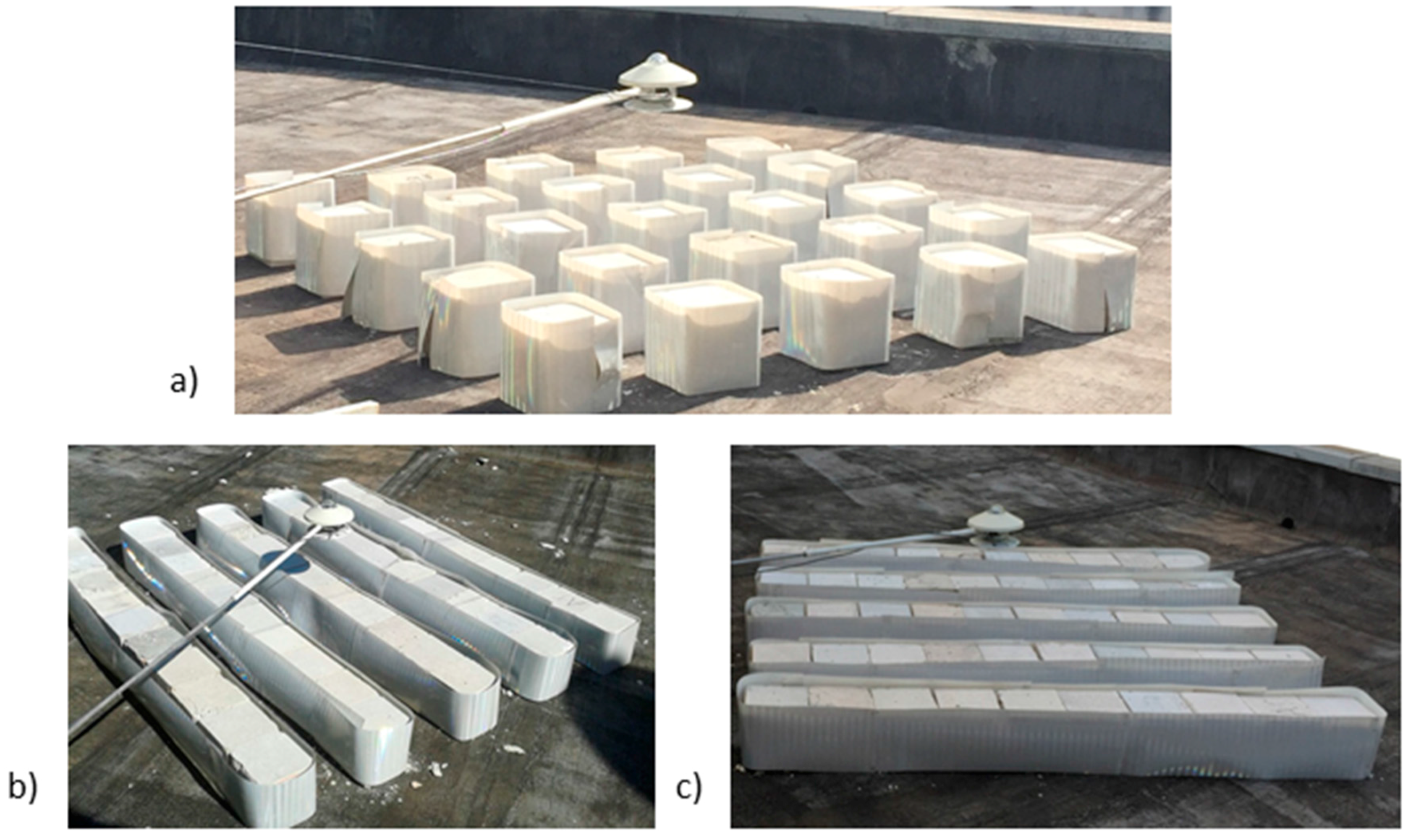

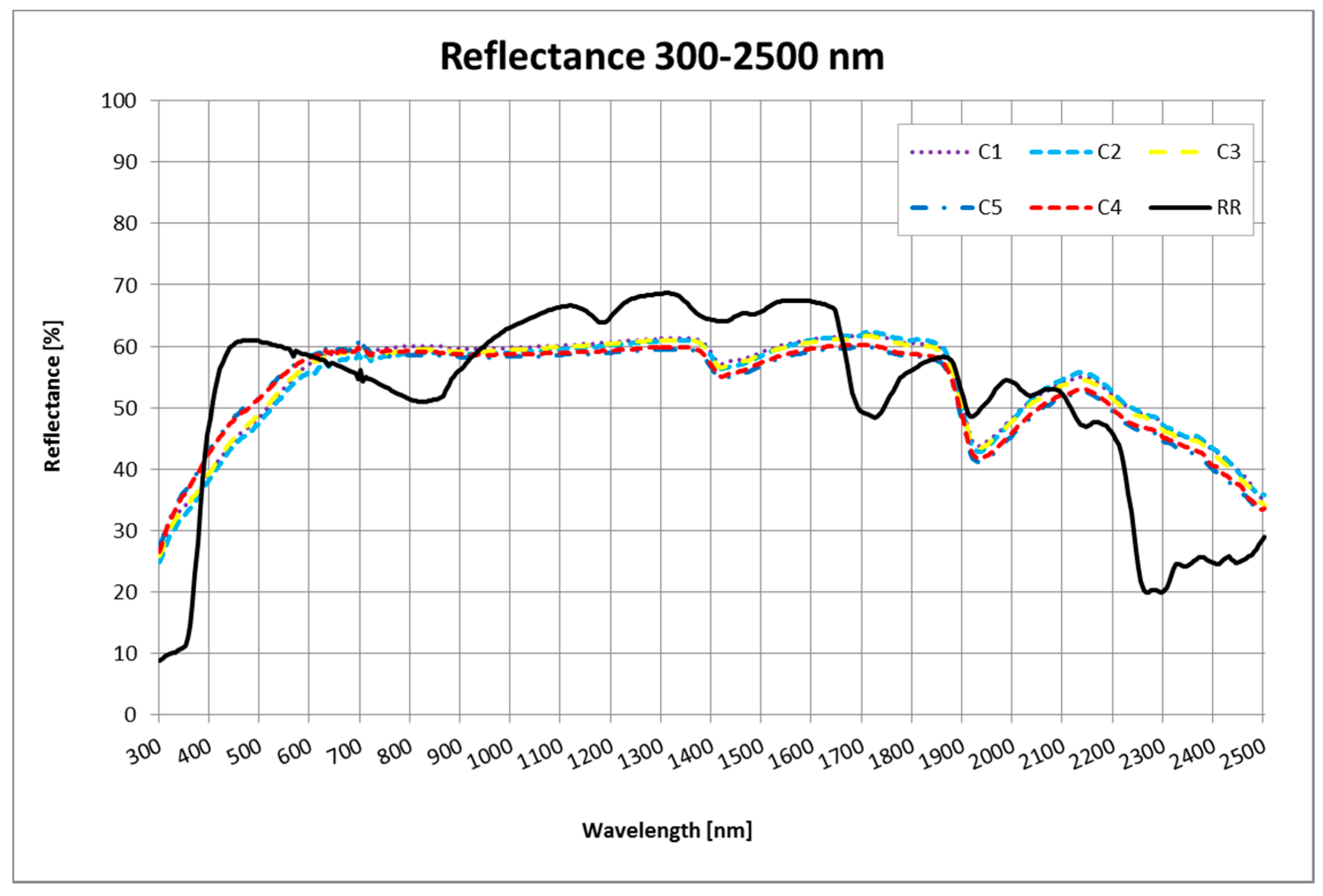
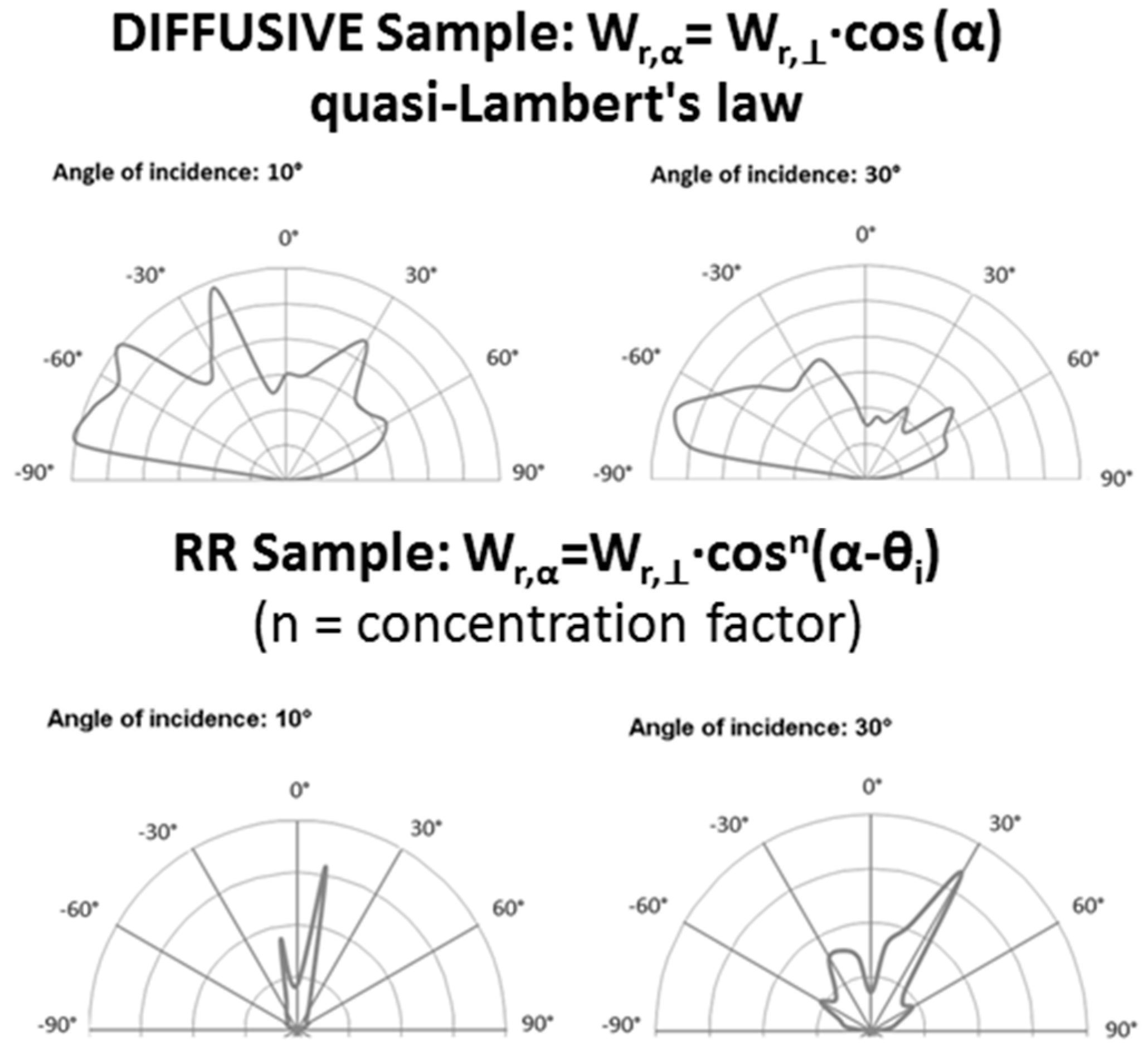
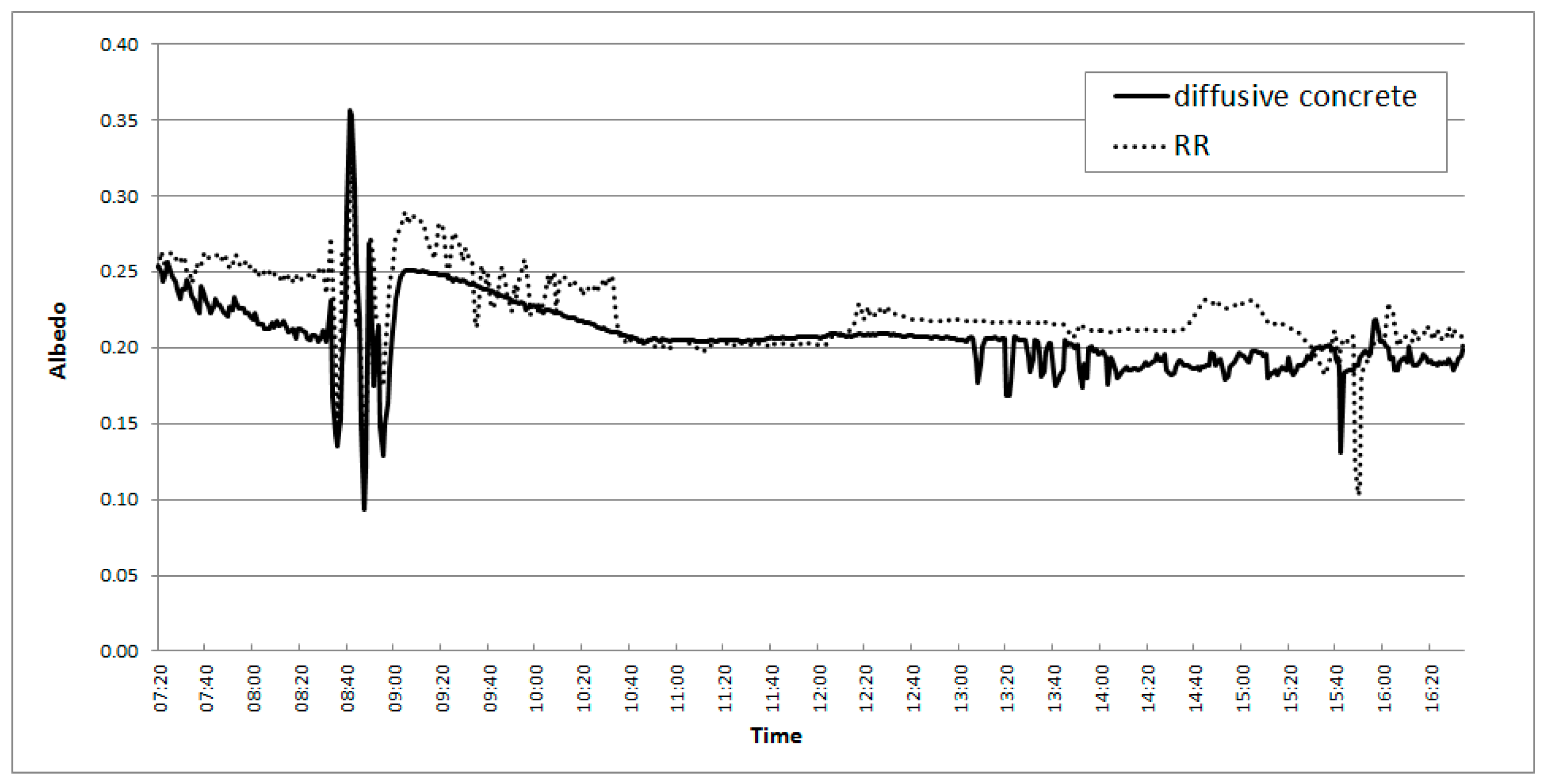
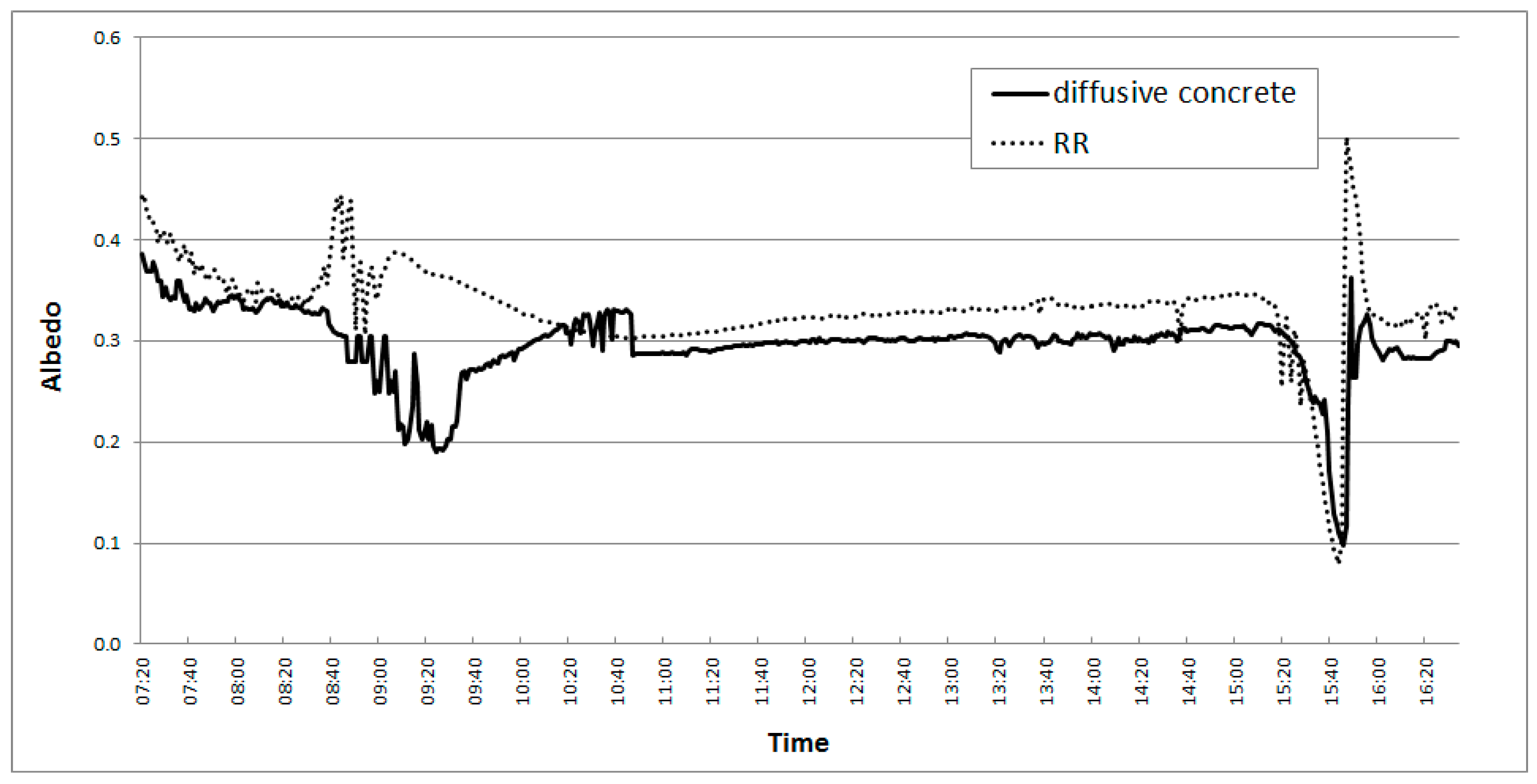
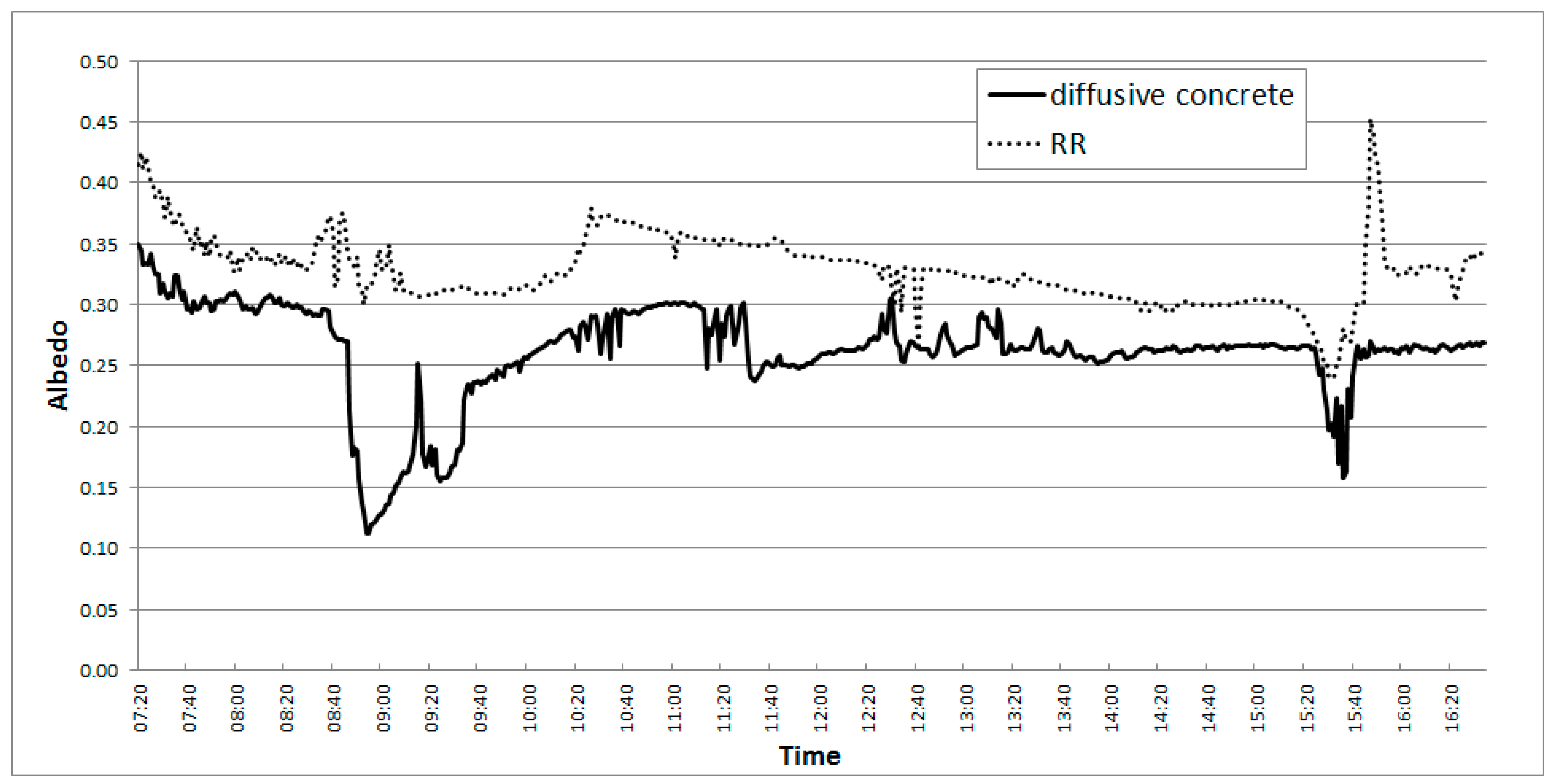
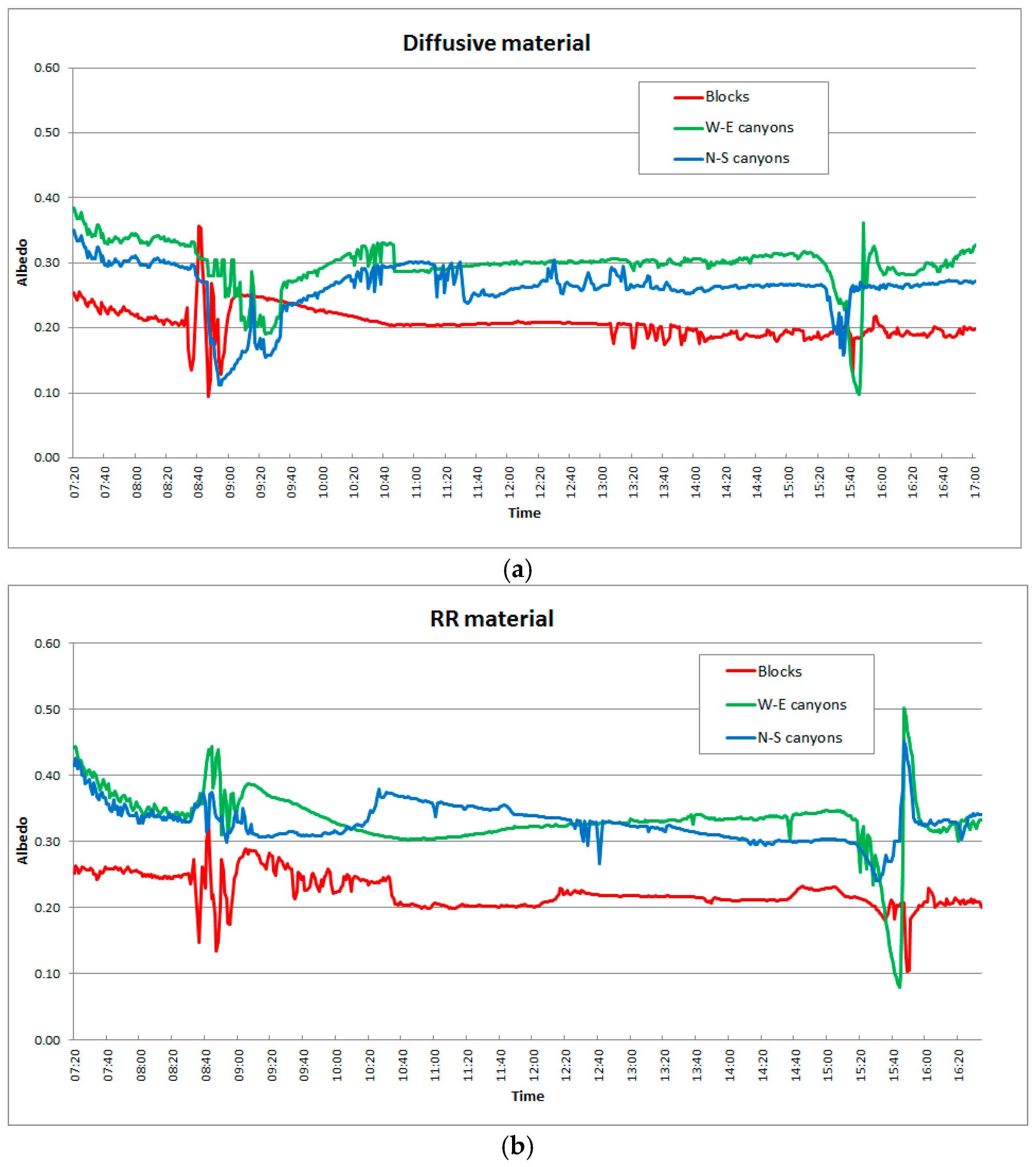
| Scheme | Equivalentalbedo(Diffusive Concrete) | Equivalent Albedo(RR) | ΔAlbedo (%) |
|---|---|---|---|
| Blocks | 0.21 | 0.24 | +3% |
| W-E canyons | 0.29 | 0.36 | +7% |
| N-S canyons | 0.28 | 0.35 | +7% |
| Urban Pattern | Solar Irradiation (MJ/m2day) | ΔEquivalent Albedo | Energy Saving (MJ/m2·day) |
|---|---|---|---|
| Blocks | 16 | 0.03 | −0.48 |
| Canyons | 16 | 0.07 | −1.12 |
© 2017 by the authors. Licensee MDPI, Basel, Switzerland. This article is an open access article distributed under the terms and conditions of the Creative Commons Attribution (CC BY) license (http://creativecommons.org/licenses/by/4.0/).
Share and Cite
Morini, E.; Castellani, B.; Presciutti, A.; Anderini, E.; Filipponi, M.; Nicolini, A.; Rossi, F. Experimental Analysis of the Effect of Geometry and Façade Materials on Urban District’s Equivalent Albedo. Sustainability 2017, 9, 1245. https://doi.org/10.3390/su9071245
Morini E, Castellani B, Presciutti A, Anderini E, Filipponi M, Nicolini A, Rossi F. Experimental Analysis of the Effect of Geometry and Façade Materials on Urban District’s Equivalent Albedo. Sustainability. 2017; 9(7):1245. https://doi.org/10.3390/su9071245
Chicago/Turabian StyleMorini, Elena, Beatrice Castellani, Andrea Presciutti, Elisabetta Anderini, Mirko Filipponi, Andrea Nicolini, and Federico Rossi. 2017. "Experimental Analysis of the Effect of Geometry and Façade Materials on Urban District’s Equivalent Albedo" Sustainability 9, no. 7: 1245. https://doi.org/10.3390/su9071245






